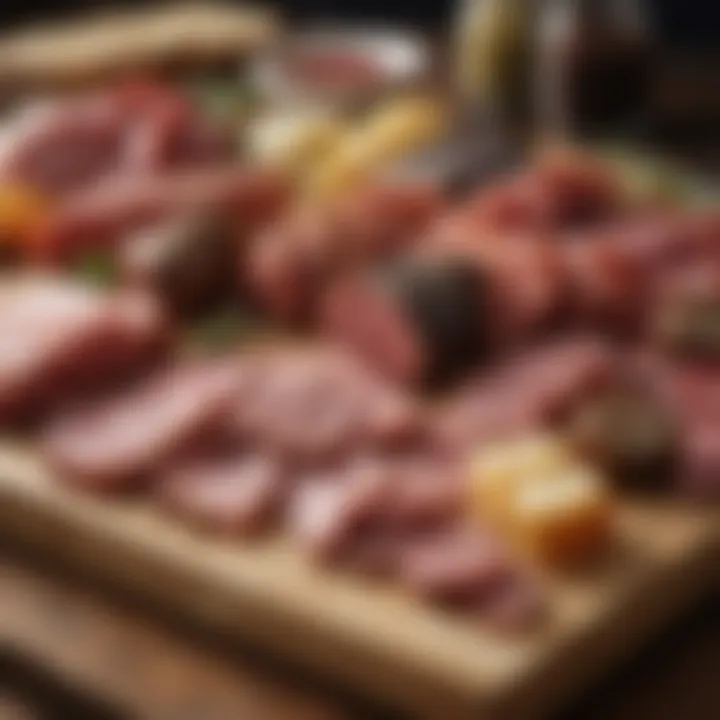Creating the Perfect DIY Charcuterie Board


Intro
Creating a charcuterie board is not just about assembling different components; it is an art form that requires careful thought and consideration. Charcuterie is a French word referring to prepared meat products, but when we talk about a charcuterie board today, we embrace a wider selection of ingredients. This guide aims to navigate through those essentials—meats, cheeses, fruits, nuts, crackers, and more. The goal is to equip both novice cooks and experienced culinary fans with the necessary knowledge to craft visually striking and delicious boards.
The charcuterie board serves various functions, from being an appetizer for gatherings to a standalone offering during a casual night in. Understanding the components that make a charcuterie board appealing both in taste and presentation is essential. Flavors should complement each other, while textures add interest. Additionally, as dietary preferences vary widely today, this guide will also explore how to customize selections accordingly, ensuring everyone can enjoy these culinary creations.
Recipe Overview
Recipe Name
DIY Charcuterie Board
Description of the Dish
The DIY charcuterie board is a carefully curated spread that invites creativity and personalization. It typically combines a variety of meats, cheeses, accompaniments, and garnishes, leading to a balanced palette of flavors and textures. This dish encourages social interaction, as it often serves as a centerpiece during gatherings.
"A well-crafted charcuterie board is an experience, not just a meal."
Ingredients
List of Ingredients with Measurements
- Meats: 4 ounces of prosciutto, 4 ounces of salami, 4 ounces of chorizo
- Cheeses: 4 ounces of Brie, 4 ounces of aged cheddar, 4 ounces of goat cheese
- Accompaniments: 1 cup of mixed olives, 1 cup of assorted nuts, 1 cup of dried fruit (like apricots or figs)
- Crackers: 1 box of water crackers, 1 box of whole grain crackers
- Garnishes: Fresh herbs (such as rosemary or thyme), edible flowers for presentation
Special Notes on Ingredients
When selecting meats, consider regional options. For instance, in Italy, you may want to add speck or coppa. Each cheese offers different flavor profiles, so it can be beneficial to taste them beforehand.
For dietary restrictions, substitute regular cheese with vegan options like cashew or almond-based cheese. Nuts can be skipped or replaced by seeds for those with nut allergies. The accompaniments can also include fresh fruits, such as apple slices or grapes, depending on the season.
By understanding the essential elements of a charcuterie board, one can create a unique and delightful presentation that caters to various tastes and preferences. This guide provides a foundation, allowing your creativity to shine in the kitchen.
Understanding Charcuterie
Understanding charcuterie is fundamental when assembling your own charcuterie board. This knowledge helps to identify key ingredients, appreciate the art of presentation, and balance various flavors. An understanding of charcuterie provides clarity on how meats, cheeses, and accompaniments complement each other, enhancing the overall experience.
This section will delve into the definition, history, and distinctions between charcuterie boards and cheese boards, arming you with necessary insights before creating your own beautiful display. The knowledge will serve not only to prepare a delicious spread but also to impress guests with an informed approach.
Definition and Origins
Charcuterie refers to a French culinary tradition focusing on prepared meat products. The term comes from the French words "chair" (meat) and "cuit" (cooked). It originally emphasized preservation methods such as curing, smoking, and salting meats to extend their shelf life before refrigeration existed.
Historically, charcuterie was a way to avoid waste and utilize various cuts of meat. Specific regions in France, like the southwest, have rich histories tied to their unique processing methods. It has evolved into a sophisticated art, with various forms of sausages and cured meats that are now enjoyed worldwide.
Charcuterie Boards vs. Cheese Boards
Understanding the difference between charcuterie boards and cheese boards is essential for curating a balanced selection. While both contain an assortment of items meant for sharing, their focuses differ significantly.
- Charcuterie Board:
- Cheese Board:
- Primarily features meats such as prosciutto, salami, and other cured items.
- Accompanied by cheeses, fruits, nuts, and spreads that complement the meats.
- Centers around a wide variety of cheeses, which may include soft, hard, and blue varieties.
- Often garnished with fruits, crackers, and spreads but usually lacks a substantial focus on meats.
Both boards can be customized to suit the occasion and preferences, but recognizing their unique aspects can assist in determining how to arrange flavors and textures effectively. A well-composed charcuterie board provides an enjoyable, sharable experience that combines savory and sweet elements.
Essential Meats for Your Board
The selection of meats is crucial when creating a charcuterie board. Ideal meats not only enhance the visual appeal but also contribute significantly to the overall flavor profile. Each type of meat brings its unique texture and taste, making the board more enticing. Understanding which meats to choose will ensure that your board captivates the palate and meets the expectations of your guests.
Cured Meats
Salami
Salami is one of the most popular cured meats. Its rich flavor, coupled with a variety of spices, makes it a crowd favorite. The key characteristic of salami is its robust taste, which comes from a mixture of pork and seasonings that are fermented and air-dried. This process allows it to develop complex flavors over time.
Salami serves as a beneficial choice because it adds depth to the board. It balances well with both cheeses and accompaniments. A unique feature of salami is its versatility; it pairs nicely with everything from sweet fruits to tangy cheeses. However, one disadvantage is that some may find its flavor a bit too strong if not balanced properly with milder ingredients.
Prosciutto
Prosciutto delivers a delicate and savory flavor profile. This dry-cured ham originates from Italy and is renowned for its sweet, subtle taste. Its key characteristic lies in its melt-in-the-mouth texture combined with a slightly salty nuance, which makes it an attractive choice for charcuterie boards.
The advantage of using prosciutto is its ability to pair harmoniously with other ingredients. Its unique texture can elevate other elements such as fruits or soft cheeses. However, prosciutto can be pricier than other meats, which might be a consideration for budget-conscious hosts.
Chorizo
Chorizo, a spicy sausage, brings a unique kick to your charcuterie board. Its key characteristic is the distinct flavor that comes from paprika and garlic, giving it a fiery and aromatic spin. This makes chorizo an interesting addition when you want to create a diverse flavor palette.
The advantage of chorizo is its boldness, which can contrast nicely with milder items and enhance the overall experience. On the flip side, the level of spice might be too much for some guests, so it should be considered carefully within the platform of flavors in your design.
Paté and Spreads
Chicken Liver Paté


Chicken liver paté offers a smooth and rich taste. This spread is made from finely blended chicken livers, cream, and seasonings. A key characteristic is its creamy consistency, which serves as a contrast to the other components on the board.
Using chicken liver paté adds sophistication and unique flavor to your charcuterie board. Its unique feature is its ability to appeal to savory lovers. However, not everyone enjoys liver, so this option might not cater to all palates.
Mushroom Paté
Mushroom paté is an excellent alternative for those seeking a vegetarian option. Made from a blend of various mushrooms, butter, and herbs, it delivers a key characteristic of earthy, umami flavors. This spread adds depth with its distinct texture and taste.
The benefits of including mushroom paté are twofold. First, it accommodates diverse dietary preferences. Second, it introduces a unique flavor that still aligns with the overall charcuterie theme. One potential downside is that its taste can be quite mild compared to other options, which may lead to it being overshadowed on the board.
Understanding the essential meats and spreads is really important for crafting a well-rounded charcuterie board, ensuring that every ingredient is carefully selected for flavor and texture.
Choosing Cheeses
Choosing the right cheeses is central in assembling a harmonious charcuterie board. The selection of cheeses contributes significantly to the overall flavor, texture, and aesthetic appeal. The right combination can elevate the entire experience, making it both enjoyable and memorable. When selecting cheeses, consider their strengths and how they will pair with meats, accompaniments, and garnishes. Here are the categories of cheeses that are often included:
Soft Cheeses
Brie
Brie is known for its creamy texture and rich flavor. It adds a sense of luxury to any charcuterie board. Its mild taste makes it versatile, allowing it to complement various meats and accompaniments. Brie typically has a soft, edible rind, which enhances its appeal. However, some may find the flavor too subtle when paired with stronger tasting items. Its unique feature lies in its melt-in-the-mouth quality, making it a crowd pleaser, especially when served at room temperature.
Goat Cheese
Goat cheese, with its tangy flavor profile, brings a distinct character to a charcuterie board. It is often available in various forms, from creamy logs to crumbled varieties. The key characteristic of goat cheese is its slightly acidic taste, which can balance out richer meats and foods. Being spreadable adds to its versatility; it works well with crackers or fruits. However, some diners may find its flavor bold, making personal preferences significant in selection.
Hard Cheeses
Cheddar
Cheddar is a staple in many cheese selections. Its sharpness varies from mild to extra sharp, allowing customization based on the intended palette. The hard texture offers a satisfying bite and pairs well with both sweet and savory accompaniments. Cheddar's widespread appeal makes it a safe choice for any occasion. However, its popularity can sometimes overshadow more unique cheeses, losing a chance to expose guests to something different.
Parmigiano-Reggiano
Parmigiano-Reggiano, often referred to as the "King of Cheeses," is celebrated for its nutty and complex flavors. It is a hard cheese that adds a sophisticated touch and can be served in shavings or chunks. The unique aging process brings out crystals that enhance texture and flavor. This cheese is a beneficial addition for enhancing umami profiles. Nevertheless, its distinct taste might not be the favorite for everyone, especially among those who prefer milder selections.
Blue Cheeses
Roquefort
Roquefort is likely one of the most iconic blue cheeses. Its intense flavor, combined with a creamy yet crumbly texture, contributes significantly to the savory notes of a charcuterie board. The blue veins provide not only visual interest but also a strong, tangy flavor that can excite the palate. Yet, this assertive profile may be polarizing; it is often loved by some and disliked by others.
Stilton
Stilton offers a unique taste that is both rich and slightly sweet. It has a crumbly texture with a creamy finish, making it ideal for pairing with fruits or sweeter accompaniments. This cheese commands attention on the board, both for its taste and appearance. It is a beneficial choice for those seeking depth in flavor, but similar to Roquefort, its boldness can limit its broader acceptance among various tastes.
Selecting a variety of cheeses introduces different textures and flavors that enhance the overall dining experience.
Accompaniments and Condiments
Accompaniments and condiments play a vital role in crafting a charcuterie board. They enhance not only the flavors but also the visual appeal of the spread. These elements introduce additional textures and tastes which balance well with meats and cheeses, making the experience more enjoyable. It is essential to choose a diverse mix of accompaniments to cater to various preferences, ensuring that each guest can find something they enjoy.
Breads and Crackers
Baguette Slices
Baguette slices are light, crisp, and perfect for pairing with meats and cheeses. Their mild flavor allows the other ingredients to shine. One key characteristic of baguette slices is their crusty exterior and soft interior, which provides an excellent balance of texture.
These slices are a popular choice because they are readily available and easy to prepare. Simply slice fresh baguette into pieces and arrange them on the board. They can absorb flavors from spreads, making them a beneficial addition. A downside is that they can become soggy after a while if not consumed quickly, so serve them fresh.
Artisan Crackers
Artisan crackers offer a variety of shapes, flavors, and textures that can enhance a charcuterie board. The unique characteristics of these crackers can complement not just the meats but also the cheeses well. Many are made with high-quality ingredients such as whole grains and seeds.
Choosing artisan crackers is beneficial because they come in various flavors, from savory to slightly sweet. This diversity allows guests to experiment with different pairings. However, it is crucial to select crackers that won't overwhelm the other flavors on the board. Some thicker varieties may overpower delicate cheeses.
Fruits
Grapes
Grapes serve as a juicy, refreshing accompaniment on a charcuterie board. Their sweetness provides a nice contrast to salty and savory flavors found in meats and cheeses. Grapes are easy to serve as they can be simply rinsed and placed whole on the board.
A key characteristic of grapes is their ability to remain fresh for a longer time, making them a practical choice. They add a touch of color and vibrancy, enhancing the overall presentation. On the downside, they may not satisfy those who prefer other fruit options.
Figs
Figs, both fresh and dried, add a touch of indulgence to the board. They provide a sweet flavor that pairs well with creamy cheeses. Figs are particularly popular for their unique texture; the seeds provide a slight crunch which contrasts nicely with soft and spreadable options.
Their unique feature is versatility; they can be served as they are or even caramelized for an extra layer of flavor. However, figs can be seasonal, which may limit their availability, presenting a challenge for some.
Apple Slices
Apple slices bring a crisp and refreshing crunch to the board. Their natural sweetness complements both meats and cheeses. The contrast between the sweet tartness of apples and rich flavors creates a balanced experience.
A key characteristic of apple slices is their bright color, which enhances the visual appeal. They are easy to prepare by simply slicing fresh apples. One downside is that they may brown quickly after being sliced, so it's advisable to toss them in lemon juice to maintain their appearance.


Pickles and Olives
Pickled Gherkins
Pickled gherkins add an acidic bite that cuts through the richness of meats and cheeses. Their crunchy texture provides a pleasant contrast. A unique feature of gherkins is their small size, making them easy to pick up and eat without any utensils.
This characteristic makes them a beneficial addition for a casual gathering. They can also be easily incorporated into various serving styles. However, their strong tangy flavor might not be preferred by everyone, which is something to consider when preparing your board.
Mixed Olives
Mixed olives offer a complexity of flavors, from mild to intensely briny. They are characteristically rich and can be employed as a dramatic visual addition to the board. The variety in olives means guests can taste different flavors, enhancing the overall culinary experience.
One benefit of including mixed olives is their versatility, fitting into many flavor profiles. They can serve as a palate cleanser between bites of rich meats. A downside is that not all guests may enjoy olives, so it’s wise to offer alternative items alongside them.
Dips and Spreads
Hummus
Hummus serves as a creamy, flavorful spread that fits well on a charcuterie board. It lends a nutty, wholesome texture that pairs beautifully with various accompaniments. A key characteristic is its versatility; it can be flavored in numerous ways, from garlic to roasted red pepper.
Hummus is a beneficial option for those seeking vegan or vegetarian choices. It encourages healthy snacking. However, be mindful of its consistency, as it may slide off of some crackers or baguette slices.
Mustard
Mustard is a bold condiment that can elevate the flavors of meats and cheeses. Its tangy and sometimes spicy profile enhances rich flavors found on the board. One unique feature of mustard lies in its varieties—whole grain, dijon, and spicy too—providing wonderful pairings.
Including mustard allows guests to customize their bites and adds a touch of gourmet flair to the presentation. However, be cautious, as its strong flavor may overpower gentler items, which could dissuade some guests.
Garnishing for Presentation
Garnishing is an often-underestimated aspect of preparing a charcuterie board. It serves both aesthetic and functional purposes. A carefully crafted garnish can elevate the overall appearance while also enhancing the flavors of the ingredients. Presenting a visually appealing board encourages guests to explore and enjoy the variety of flavors available. Additionally, garnishes can add contrasting textures and aromas that invite diners to indulge. When thoughtfully selected, garnishes such as herbs, nuts, and sweets add depth and complexity to your charcuterie experience.
Herbs and Greens
Rosemary
Rosemary, with its robust flavor and aromatic profile, holds a unique position in garnishing charcuterie boards. Its key characteristic is the pine-like scent, which can stimulate appetite and enhance the tasting experience. Rosemary is a popular choice for this article due to its versatility and ability to pair well with a variety of cheeses and meats. It can add a fresh element that balances richer items on the board.
A unique feature of rosemary is its durability. Unlike some delicate herbs, it remains vibrant even when placed nearby stronger-flavored ingredients. This strength ensures it can stand out without overpowering the other components, thus offering a suitable garnish option. However, rosemary should be used in moderation to avoid overwhelming the palate.
Basil
Basil introduces a fresh and slightly sweet undertone, making it an excellent herb for garnishing charcuterie boards. Its bright green leaves appeal visually, creating a pop of color against the more muted tones of meats and cheeses. Basil can also complement a wide range of flavors present on the board, making it a beneficial addition to the overall mixture.
A unique feature of basil involves its fragrance. The distinct aroma of basil enhances the sensory experience for guests, inviting further exploration. Nevertheless, basil can wilt quickly if not handled properly, requiring attention to presentation. Ensuring it is lively at serving time can significantly impact the board's appearance.
Nuts and Sweets
Almonds
Almonds are a highly valued choice for charcuterie boards due to their balanced flavor and texture. Their crunchy nature contrasts well with softer cheeses and meats, providing a satisfying bite. Furthermore, almonds are rich in healthy fats and protein, offering nutritional benefits alongside their culinary worth.
The key characteristic of almonds is their versatility. They can be served raw, roasted, or spiced, catering to diverse palates. This adaptability makes almonds a beneficial component in a charcuterie presentation. However, their hard texture might not be suitable for some guests who prefer softer options on the board.
Dark Chocolate
Dark chocolate is an intriguing addition that brings sweetness and richness to a charcuterie board. Its complex flavor profile can both complement and contrast with salty meats and tangy cheeses, creating a harmonious balance. The key trait of dark chocolate lies in its ability to satisfy a sweet craving while still being sophisticated enough to enhance the board's overall appeal.
A unique feature of dark chocolate is its variety in sweetness levels, allowing you to select according to preferences. It can provide an elegant finish to your charcuterie experience. However, care must be taken regarding portion sizes and pairing, as not all guests may enjoy the intensity of dark chocolate.
Accommodating Dietary Preferences
The inclusion of diverse dietary preferences in your charcuterie board is crucial in creating an enjoyable experience for all your guests. As social gatherings often bring together people with different eating habits, addressing these varying needs ensures that everyone can participate in the enjoyment of the spread. Ignoring dietary restrictions can lead to discomfort or exclusion, which is not the intent of a charcuterie board. By thoughtfully selecting ingredients that cater to vegans and those who require gluten-free options, you enhance the overall appeal of your board.
Vegan Options
Plant-Based Cheeses
Plant-based cheeses are an excellent choice for providing alternatives to traditional dairy products. These cheeses are often made from nuts, seeds, or soy, offering distinct flavors and textures. They are rich in healthy fats and can be surprisingly creamy, making them a beneficial addition to a charcuterie board. Notably, vegan cheese allows individuals avoiding dairy to enjoy rich flavors without compromising their dietary choices.
However, one must consider the unique nature of these products. While some vegan cheeses are flavorful, others may lack the depth found in their dairy counterparts. Careful selection and tasting are encouraged to ensure that the flavors align with the overall profile of your board.
Vegetable Dips
Vegetable dips significantly enhance a charcuterie board by offering freshness and flavor. These dips can be made from various vegetables, like peppers or carrots, blended with spices and herbs. They are refreshing, and provide a vibrant contrast to the heavier elements of the board. Furthermore, dips like hummus or guacamole are particularly popular because they pack a punch of flavor and can complement both fresh vegetables and crackers.
The versatility of vegetable dips makes them a desirable option for a wide audience, including those who may be avoiding dairy or animal products altogether. While they add a delightful texture, it is key to prepare them well so that the flavors shine and elevate the entire board.
Gluten-Free Choices
Gluten-Free Crackers
Gluten-free crackers present a necessary option for those with gluten sensitivities or celiac disease. These arent just safer for individuals with restrictions; they can also introduce exciting flavors and textures. Often made with alternative grains such as rice, almond, or chickpea flour, gluten-free crackers can be just as crispy and satisfying as standard versions.


Their main advantage lies in their ability to diversify the offerings of your board, catering to gluten intolerant guests without compromising taste. However, it is important to note that not all gluten-free crackers are created equal; some might be overly dry or crumbly. Testing different brands may help pinpoint the most enjoyable options for inclusion.
Fresh Veggies
Including fresh veggies is a straightforward yet effective way to cater to dietary needs. They are naturally gluten-free and offer numerous health benefits. The crispness of fresh vegetables adds a refreshing crunch, balancing out richer items on the charcuterie board. Popular choices like cucumbers, cherry tomatoes, and bell pepper slices are often well-received.
Vegetables also serve a dual purpose. They add color and vibrancy to the presentation and function as a healthy option that appeals to a broader range of guests. The downside may be their seasonal availability or freshness, which necessitates careful selection prior to assembling your board.
Crafting the Board
Crafting the board is a crucial aspect of assembling a DIY charcuterie experience. It involves thoughtful considerations in selecting not just the ingredients but also the board that will carry them. The board serves as both a functional tool and an aesthetic centerpiece. Therefore, the choice of materials, size, and arrangement plays a significant role in how inviting and appetizing your presentation will appear.
Choosing the right board can enhance the visual appeal and practicality. A well-chosen board allows for seamless placement of meats, cheeses, and accompaniments, while also ensuring that the flavors are easy to explore. It's also about striking a balance between functionality and style, which can engage and satisfy your guests.
Selecting the Right Board
Wooden Boards
Wooden boards are a classic option that brings warmth and rustic charm to any charcuterie presentation. Their unique grain patterns and textures make each board distinct and visually appealing. One key characteristic of wooden boards is their durability; they can withstand a variety of cuts, which is excellent when preparing and serving different products.
Wooden boards are also beneficial because they can enhance the flavors of certain foods. For example, the natural oils in wood can help impart a subtle taste that complements the meats and cheeses. However, they do require specific maintenance, such as regular oiling to prevent drying or cracking.
Advantages of wooden boards include being visually striking and making for a more engaging presentation. Yet, they can be challenging to clean, as they may retain odors or stains from strong-flavored items.
Marble Slabs
Marble slabs offer a sleek, elegant surface for your charcuterie board. Their cool temperature can be particularly effective for certain cheeses, keeping them fresh longer. A key characteristic of marble slabs is their ability to present food beautifully, elevating the entire experience.
These slabs are popular among hosts due to their non-porous nature, making them easy to clean. This can be a significant benefit for those who prioritize sanitation while entertaining. The unique feature of marble, being heavier and sturdy, ensures that it won’t easily shift during serving, enhancing stability.
While marble slabs provide a refined look and ease of cleaning, they can be less forgiving if you slice cured meats directly on them. This can lead to scratches, and excessive cutting may mar their beautiful surface.
Arranging Ingredients
Arranging ingredients thoughtfully on the board can make a significant difference in the overall presentation and enjoyment of the meal.
Color Coordination
Color coordination is essential for creating a visually appealing charcuterie board. Different colors invite the eye and stimulate interest, making the assortment more appealing. Combining bright fruits with earthy meats and creamy cheeses creates contrast and a lovely visual balance.
The key characteristic of smart color coordination is its ability to highlight the diversity of the offerings. By grouping similar colors or contrasting hues, you can draw attention to certain elements of the board. Colors play a psychological role in how food is perceived, influencing appetite and enjoyment.
The unique advantage of color coordination is that it encourages diners to explore the different flavors and textures available. However, achieving a well-coordinated board takes planning, as choices need to be deliberate and considerate of one another.
Layering Techniques
Layering has a functional role in enhancing the experience of the charcuterie board. This technique involves stacking and arranging ingredients in a way that maximizes space and accessibility. It brings depth and dimension, so guests have an easier time selecting items.
The key characteristic of layering is its ability to create a more dynamic presentation. By placing taller items like cheeses or spreads in the back and spreading out the flatter items in the front, you build a scenic view that invites guests to indulge.
Unique to layering techniques is the possibility of optimizing the board space. This ensures all ingredients are accessible. However, improper layering can lead to a messy presentation, where items may overreach or overlap awkwardly. It is essential to consider how each element interacts within the arrangement to maintain both aesthetics and functionality.
Serving and Enjoying
The process of serving a charcuterie board extends beyond simply placing ingredients on a platter. It allows you to create an experience that caters to both taste and presentation. This stage is essential as it directly influences how guests perceive and enjoy the board. Serving properly can enhance flavors, spark conversation, and create a positive ambiance. The right combination of accompaniments and beverages can elevate the meal to a more sophisticated dining experience.
Accompanying Beverages
Wine Pairings
Wine pairings are critical to the success of a charcuterie board. The right wine complement flavors of the meats and cheeses, creating a harmonious balance. For example, a crisp white wine might enhance the saltiness of prosciutto, while a bold red could be perfect with aged cheddar.
The key characteristic of wine pairings is the ability to enhance the tasting experience. It helps highlight the flavors in food, making them more pronounced. This combination is popular among those who appreciate the culinary art because it opens up new tasting experiences.
A unique feature of wine pairings is their versatility. Different wines can change the experience entirely. However, it is important to know that not everyone enjoys wine. Accessibility can be an issue if guests are not wine drinkers.
Craft Beers
Craft beers present an interesting option for pairing with a charcuterie board. With their wide range of flavors, craft beers can stand up to different ingredients. IPAs, for example, provide a bitter note that cuts through creamy cheeses, while stouts can complement rich meats like chorizo.
The distinctness of craft beers lies in their variety. They often offer flavors ranging from hoppy to malty, which can appeal to various palates. Craft beers are beneficial for gatherings where guests might prefer them over wine, making it inclusive.
One disadvantage is that the flavors of craft beers might not always align with the flavors of your board. Pairing requires a careful selection to ensure harmony rather than clashing flavors.
Tips for Serving
Serving Utensils
Serving utensils are essential for a well-organized presentation. They facilitate easy access to various components of the board. Having separate utensils for each ingredient type prevents mingling of tastes. For instance, using a cheese knife for soft cheese like Brie ensures its integrity while reducing contamination.
The characteristic of serving utensils is their role in convenience. They allow guests to efficiently serve themselves, catering to personal portions and preferences. Their importance lies in tidiness and ease of use.
Sometimes, people overlook this detail, which can lead to confusion when serving. Providing clear options is critical for enhancing the experience.
Portion Control
Portion control is a significant aspect when serving a charcuterie board. It ensures that guests can enjoy a variety of options without overindulging in any one item. Balancing portions allows for a taste of everything, promoting a well-rounded experience.
The key characteristic here is moderation. Controlling portions helps manage dietary needs and preferences, making the board accessible. It can prevent waste while also satisfying diverse appetites.
With scrutiny, it's essential for awareness of guests' tastes and limits. Portioning recommend is beneficial as it gives everyone an opportunity to enjoy a small sampling of the board. As a result, portion control contributes both to food management and satisfaction.







